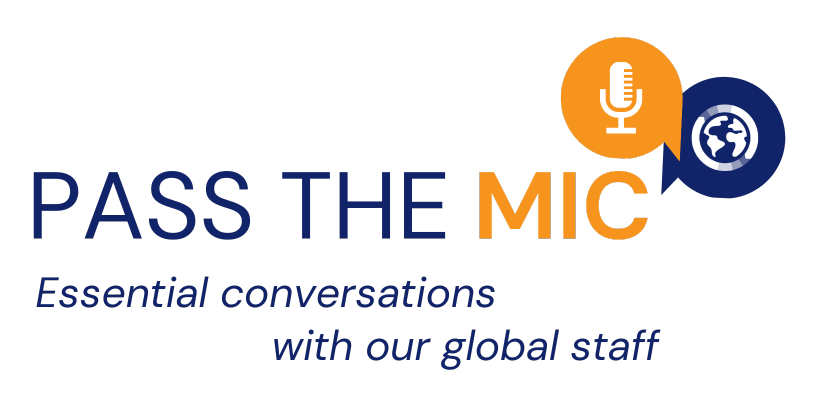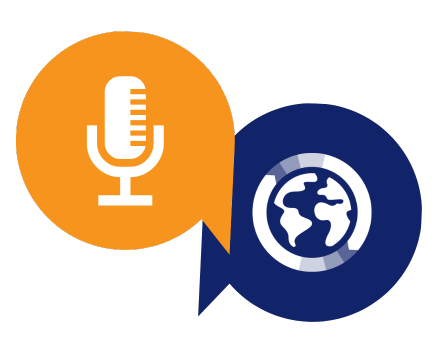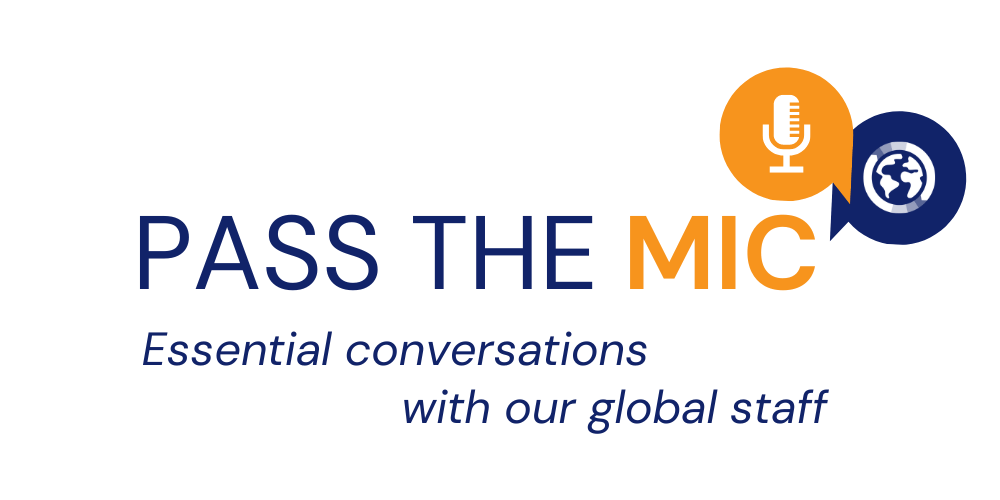News > Blog
Pass the Mic: Localizing Child Protection Interventions in Ukraine’s Humanitarian Context
Published 09/27/2024 by Global Communities
By Paula Rudnicka, Sr. Manager for Public Affairs

Global Communities has a rich history of implementing Child Protection in Emergencies programs. Our interventions are multifaced, ranging from psychosocial counselling and art therapy classes to life skills, literacy and parenting sessions. In countries where institutional services are weak, Global Communities delivers these services directly, including through child-friendly spaces and mobile teams. In other countries, such as Ukraine, these services are delivered by local actors, with technical assistance from Global Communities’ national staff and the Global Support Team.
In this interview, Emily Galloway, our Sr. Technical Advisor for Protection, shares how Global Communities is applying localization principles to child protection interventions within our Community-led Emergency Action and Response (CLEAR) program in Ukraine. CLEAR works in the Chernihiv, Chernivtsi, Dnipropetrovsk and Kharkiv oblasts to address urgent protection, shelter, water, sanitation and hygiene needs among conflict-affected populations.
The conversation was edited for length and clarity.

Paula: CLEAR is grounded in the principles of localization. How has Global Communities applied these principles to the program design and implementation?
![]()
Emily: Global Communities has been implementing a development program focused on local governance in Ukraine since 2016. When Russia’s full-scale invasion began in 2022, we were able to quickly leverage our existing relationships with local communities to craft a locally led response to the humanitarian crisis. Thankfully, our donor—the United States Agency for International Development’s Bureau for Humanitarian Assistance (USAID/BHA)—was receptive to a program that was much different from our typical approach.
First, our proposal was much less detailed than usual. Instead of listing exact activities, locations and partners, we provided a scope of what we might do depending on our partners’ interest. Of course, we included standard child protection activities, such as awareness raising and case management, but we built in flexibility that would allow us to co-create specific interventions with local partners.
Second, our partner selection process was different. Instead of focusing solely on partners with the greatest capacity and experience, we selected organizations that were motivated to enter the humanitarian sphere or eager to gain child protection expertise. This tiered partnership model allowed us to work both with larger organizations that could launch a rapid emergency response with minimal support and smaller organizations that were missing from the crisis response. For example, we included women-led groups and community-based organizations operating in rural, less populated areas, where government services are not available. This way we could address niche needs in hard-to-reach communities.
Third, we invested time and resources in the co-creation process. We provided our partners with activity options, and they shared with us community needs. Together, we agreed on their scope of work in child protection.
And finally, we worked with each partner on a tailored capacity strengthening plan. Certain things were not negotiable. For example, all of our partners had to be familiar with humanitarian principles, minimum standards on child protection, child safeguarding and donor’s rules and regulations. Otherwise, the partners could choose their own growth objectives.
Paula: What are the enabling factors for applying the localization approach in Ukraine’s humanitarian context?
![]()
Emily: Ukraine has a very strong civil society and a decentralized governance system, which we have worked with for years. This has allowed us to capitalize on community strengths and often work within existing structures. For example, our partners could relatively easily establish child-friendly spaces in local schools, libraries or other community centers. In addition, Ukraine has an excellent cadre of psychologists, who were already providing services to children prior to the conflict. What they needed was upskilling. We trained them on how to respond to the needs of children in conflict settings and offered them tools to expand their services. Now, many of them use art therapy, which is a very effective therapeutic modality in times of crisis.
In addition, we have heavily relied on our amazing national staff. They are highly dedicated, motivated and invested in their communities, and they have played a leading role in designing and implementing the program.

Paula: What are the challenges of localizing humanitarian assistance interventions?
![]()
Emily: The greatest challenge is competing priorities, specifically the need to balance life-saving emergency assistance with capacity strengthening activities, such as training, mentorship and lots of meetings and discussions. On the one hand, we have children who urgently need protection services. On the other hand, we have minimum standards and donor compliance requirements which our partners are
obligated to follow. It takes a lot of time and effort to do both in parallel, especially with more than a dozen organizations.
A short timeframe of humanitarian projects complicates things further. We typically have 12, maybe 18 months to do start up, implementation and close down. Furthermore, child protection is usually one of many components of a humanitarian project, so there is a lot to juggle.
Paula: Balancing the need for rapid response with the need to strengthen local capacities is complicated. How do you address this challenge?
![]()
Emily: The key is to select highly motivated partners, prioritize activities that can be implemented early on, and then layer additional activities when possible. When it comes to capacity strengthening, it is crucial to distinguish strict requirements (e.g., child safeguarding or financial compliance) from good practices (e.g., recommended child protection tools), and focus on what is necessary and most important at a given time. It is also imperative to focus on the practical side of capacity development so that local partners can easily apply the knowledge they have gained in their daily operations. This includes ongoing technical assistance, collaborative decision-making and real-time support. Finally, it is important to leverage existing resources and coordination mechanisms, such as protection clusters.
All of this requires frequent tweaks and adaptations, which can be quite overwhelming for us and our partners. But ultimately, we have better programming, which is more sustainable and responsive to the niche needs of the communities we work with.
Paula: How have you adapted your standard approaches to operationalize localization principles under CLEAR?
![]()
Emily: First, we had to acknowledge the uncertainty that comes with a flexible program design. We could not simply implement a one-size-fits-all approach to child protection. Instead, we had to leave room for trial and error and simplify our processes so that we could more easily adapt the program to the ever-changing community needs.
Second, we had to become more comfortable with power- and resource-shifting. This required a critical reflection about our role in the program. Ultimately, we have received funding for the project, and we are accountable for its technical quality. Yet we are putting our partners in the driver’s seat. Building trust with our partners has been incredibly important. We are now in the second phase of the program, and we have made a lot of progress.
And third, we have been very intentional about addressing burnout among our staff and partners. They are the ones who work on the frontlines of an international conflict. They experience both direct and vicarious trauma. And on top of that, they absorb so many burdens of working on a humanitarian assistance project. Their health and well-being is our top priority and we have included funding for staff care into our budget. We have also encouraged our partners to incorporate it in their budgets.

Paula: What are some of the most significant localization achievements of the CLEAR program? What are you most proud of?
![]()
Emily: One of our objectives is to strengthen our partners’ capacity so that they can receive direct funding from other donors. One of such organizations is Lampa: a young, small and very motivated organization working on the frontlines of the conflict in the east of Ukraine. Lampa is an amazing partner. They provide comprehensive child protection services and really understand children’s layered needs. Thanks to CLEAR, Lampa now receives independent funding from the United Nations and other donors.
Another objective is to reach communities and vulnerable groups that would be otherwise overlooked by donors and international organizations. We have had many successes in this regard. For example, we have partnered with Civic Initiatives, which works in small, rural areas to train local art therapists who can then remain in their communities and serve the needs of children in the long run. I am also excited about the work of larger organizations, such as Chernihiv European and Search for Innovation, which engage local grassroots groups to provide services to children with disabilities.
The key takeaway is that localization is possible from the beginning of a crisis. It is not easy, and it requires adaptation, but it ensures greater sustainability and responsiveness to community needs.
Paula: What changes would you recommend at the policy level to better support localization efforts in humanitarian interventions?
![]()
Emily: I have several recommendations for humanitarian donors:
1. Require adequate budgeting for capacity strengthening. Both international and local partners need solid funding for capacity strengthening activities, including training, mentoring and ongoing support. We cannot expect local partners to comply with the requirements and minimum technical standards they are not familiar with.
2. Encourage flexibility in program design and co-creation with local partners. In a rapidly changing context, interventions included in a proposal may no longer be the priority once the program rolls out. For example, no one anticipated local markets in liberated areas of Ukraine to resume so quickly. As a result, many actors distributed large amounts of non-food items (NFIs) when they could have balanced the NFIs with vouchers or cash assistance to support local businesses. The co-creation process allows us to address the most pressing needs and gaps as they emerge.
3. Fund longer projects. The standard 12- or 18-month timeframe is insufficient to build rapport and trust with local partners and to implement parallel humanitarian assistance and capacity strengthening interventions.
4. Simplify compliance requirements and decentralize decision-making. We can streamline and speed up program implementation if our in-country staff can approve partnerships under a certain financial threshold, and if our partners are less bogged down in bureaucracy.
Paula: Thank you for your insights. How can our audiences learn more about CLEAR and our child protection activities?
![]()
Emily: I encourage you to watch the recording of my presentation about this topic, which I delivered at the 2024 Annual Meeting for Child Protection in Humanitarian Action. To learn more about our protection programming, please read my recent blog Protecting Children in Emergencies: Perspectives from Syria and Ukraine and review our technical factsheet, Protection in Emergencies. You can also find me on LinkedIn.

Emily Galloway
Sr. Technical Advisor, Protection
Emily has more than ten years of experience working domestically and internationally with displaced and crisis-affected populations. With Global Communities, she is responsible for providing technical support and guidance to humanitarian protection programs, including Child Protection and Gender-Based Violence, and leading protection mainstreaming efforts within the Humanitarian Assistance portfolio. Emily also has experience in Safeguarding and PSEA in emergency response and is dedicated to ensuring we provide support to communities safely and with dignity. Prior to Global Communities, Emily worked for the International Labour Organization, primarily implementing child labor programming in Somalia. She also supported refugees newly resettled in the U.S. in many capacities.
Emily holds a Bachelor of Arts degree in International Relations and Political Science from Washington University in St. Louis and a Master’s Degree in Peace & Conflict Studies from the University of St. Andrews.

Global Communities is home to a diverse team of professionals with a broad range of expertise and perspectives that help us build the world we envision: one of expanded opportunity, where crises give way to resilience and all people thrive. In our new “Pass the Mic” series, our global staff share innovative ideas and in-depth insights on timely topics spanning the development, humanitarian and peace nexus. Learn how our colleagues are co-creating a more just, prosperous and equitable global community.





